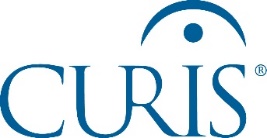0001108205false00011082052023-07-062023-07-06
UNITED STATES
SECURITIES AND EXCHANGE COMMISSION
Washington, D.C. 20549
_____________________
FORM 8-K
_____________________
CURRENT REPORT
Pursuant to Section 13 or 15(d) of the Securities Exchange Act of 1934
Date of Report (Date of earliest event Reported): July 6, 2023
Curis, Inc.
(Exact Name of Registrant as Specified in Charter)
|
|
|
|
|
|
|
|
|
| Delaware |
000-30347 |
04-3505116 |
| (State or Other Jurisdiction of Incorporation) |
(Commission File Number) |
(I.R.S. Employer Identification Number) |
|
|
|
128 Spring Street, Building C - Suite 500, Lexington, MA 02421 |
| (Address of Principal Executive Offices) (Zip Code) |
(617) 503-6500
(Registrant's telephone number, including area code)
Not Applicable
(Former name or former address, if changed since last report)
|
|
|
|
|
|
|
|
|
| Check the appropriate box below if the Form 8-K filing is intended to simultaneously satisfy the filing obligation of the registrant under any of the following provisions: |
| |
☐ |
Written communications pursuant to Rule 425 under the Securities Act (17 CFR 230.425) |
| |
☐ |
Soliciting material pursuant to Rule 14a-12 under the Exchange Act (17 CFR 240.14a-12) |
| |
☐ |
Pre-commencement communications pursuant to Rule 14d-2(b) under the Exchange Act (17 CFR 240.14d-2(b)) |
| |
☐ |
Pre-commencement communications pursuant to Rule 13e-4(c) under the Exchange Act (17 CFR 240.13e-4(c)) |
Securities registered pursuant to Section 12(b) of the Act:
|
|
|
|
|
|
|
|
|
|
|
|
|
|
|
|
|
|
| Title of each class |
|
Trading Symbol |
|
Name of each exchange on which registered |
| Common Stock, Par Value $0.01 per share |
|
CRIS |
|
Nasdaq Capital Market |
Indicate by check mark whether the registrant is an emerging growth company as defined in Rule 405 of the Securities Act of 1933 (§230.405 of this chapter) or Rule 12b-2 of the Securities Exchange Act of 1934 (§240.12b-2 of this chapter).
Emerging growth company ☐
If an emerging growth company, indicate by check mark if the registrant has elected not to use the extended transition period for complying with any new or revised financial accounting standards provided pursuant to Section 13(a) of the Exchange Act. ☐
Item 7.01. Regulation FD Disclosure.
On July 6, 2023, Curis, Inc. (“Curis” or the “Company”) issued a press release announcing that the U.S. Food and Drug Administration (“FDA”) has removed the partial clinical hold on the Company’s TakeAim Leukemia Phase 1/2 study (NCT04278768) of emavusertib (CA-4948) and that the recommended phase 2 dose (“RP2D”) for emavusertib as a monotherapy has been established at 300 mg twice daily (“BID”) in patients with Acute Myelogenous Leukemia (“AML”) or Myelodysplastic Syndromes (“MDS”). The full text of the press release issued in connection with this announcement is attached as Exhibit 99.1 to this Current Report on Form 8-K and incorporated herein by reference.
From time to time, the Company conducts meetings with third parties in which the Company utilizes a corporate slide presentation. A copy of the Company’s current corporate slide presentation is attached as Exhibit 99.2 to this Current Report on Form 8-K and incorporated herein by reference.
The information in this Item 7.01 (including Exhibits 99.1 and 99.2 attached hereto) shall not be deemed “filed” for purposes of Section 18 of the Securities Exchange Act of 1934 (the “Exchange Act”) or otherwise subject to the liabilities of that section, nor shall it be deemed incorporated by reference in any filing under the Securities Act of 1933 or the Exchange Act, except as expressly set forth by specific reference in such a filing.
Item 8.01. Other Events.
TakeAim Leukemia study
As previously disclosed, on April 4, 2022, the Company announced that the FDA placed a partial clinical hold on the TakeAim Leukemia study. On August 30, 2022, the Company announced that the FDA notified Curis that it may resume enrollment of additional patients in the monotherapy dose finding phase of the TakeAim Leukemia study, so that the Company could enroll at least nine additional patients at the 200 mg BID dose level. On July 6, 2023, the Company announced that the FDA had removed the partial clinical hold on the TakeAim Leukemia study and that the RP2D for emavusertib as a monotherapy has been established at 300 mg BID in patients with AML or MDS.
The Company is working with clinical sites to enroll targeted patients with AML (patients with a FLT3 or spliceosome mutation who have received ≤ 2 prior lines of treatment). The Company plans to initiate a front-line combination study of emavusertib with azacitidine and venetoclax. In 2024, the Company expects to have updated data from the TakeAim Leukemia monotherapy study, clarification of a monotherapy registrational study design, and initial data from an azacitidine and venetoclax combination study.
In the TakeAim Leukemia study, as of the March 17, 2023 data cutoff for patients dosed prior to February 9, 2023, 84 patients received emavusertib monotherapy, ranging from doses of 200 mg to 500 mg BID. Significant blast count reductions have been observed across all patient groups, regardless of dose level, mutation status, or number of prior lines of treatment. Emerging from these data are two genetically-defined subpopulations of relapsed/refractory (R/R) patients who have demonstrated compelling responses in monotherapy: AML patients with FLT3 mutation and AML patients with spliceosome mutation (U2AF1 or SF3B1 mutation) who have received ≤ 2 prior lines of treatment. In these subpopulations of evaluable patients (patients whose disease has been determined to be evaluable for objective response with baseline and post-treatment marrow assessments) treated with 300 mg BID, 2 of 3 patients with a FLT3 mutation achieved a CR (Complete Response) and 2 of 3 patients with spliceosome mutation achieved a CR or CRh (Complete Response with Partial Hematologic Recovery). The duration of response for these patients ranged from 5.6 to 7.0 months.
Cautionary Note Regarding Forward-Looking Statements
This Current Report on Form 8-K contains forward-looking statements within the meaning of the U.S. Private Securities Litigation Reform Act of 1995, including, without limitation, any statements with respect to Curis’s plans, strategies and objectives to resume and further patient enrollment in its TakeAim Leukemia study, initiate a front-line combination study of emavusertib with azacitidine and venetoclax, and provide updated data from such studies and clarification of a monotherapy registrational study design for its TakeAim Leukemia study, statements concerning product research, development, clinical trials and studies and commercialization plans, timelines, anticipated results or the therapeutic potential of drug candidates including any statements regarding the initiation, progression, expansion, use, safety, efficacy, dosage and potential benefits of emavusertib in clinical trials as a monotherapy and/or as a combination therapy, the progression, use and potential benefits of CI-8993, Curis’s plans and timelines to provide preliminary, interim and/or additional data from its ongoing or planned clinical trials, its ability to further patient enrollment in its TakeAim Leukemia and TakeAim Lymphoma studies, any statements concerning Curis’s expectations regarding its interactions with the FDA, statements with respect to mutations or potential biomarkers, and statements of assumptions underlying any of the foregoing.
Forward-looking statements may contain the words “believes,” “expects,” “anticipates,” “plans,” “intends,” “seeks,” “estimates,” “assumes,” “predicts,” “projects,” “targets,” “will,” “may,” “would,” “could,” “should,” “continue,” “potential,” “focus,” “strategy,” “mission,” or similar expressions. These forward-looking statements are not guarantees of future performance and involve risks, uncertainties, assumptions and other important factors that may cause actual results to be materially different from those indicated by such forward-looking statements. For example, the FDA may take further regulatory action with regard to Curis’s clinical trials. Curis may experience adverse results, delays and/or failures in its drug development programs and may not be able to successfully advance the development of its drug candidates in the time frames it projects, if at all. Curis’s drug candidates may cause unexpected toxicities, fail to demonstrate sufficient safety and efficacy in clinical studies and/or may never achieve the requisite regulatory approvals needed for commercialization. Favorable results seen in preclinical studies and early clinical trials of Curis’s drug candidates may not be replicated in later trials. There can be no guarantee that the collaboration agreements with Aurigene and ImmuNext, or the CRADA with NCI, will continue for their full terms, that Curis or its collaborators will each maintain the financial and other resources necessary to continue financing its portion of the research, development and commercialization costs, or that the parties will successfully discover, develop or commercialize drug candidates under the collaboration. Regulatory authorities may determine to delay or restrict Genentech’s and/or Roche’s ability to continue to commercialize Erivedge in basal cell carcinoma. Competing drugs may be developed that are superior to Erivedge. In connection with its agreement with Oberland Capital, Curis faces risks relating to the transfer and encumbrance of certain royalty and royalty-related payments on commercial sales of Erivedge, including the risk that, in the event of a default by Curis or its wholly-owned subsidiary, Curis could lose all retained rights to future royalty and royalty-related payments, Curis could be required to repurchase such future royalty and royalty-related payments at a price that is a multiple of the payments it has received, and its ability to enter into future arrangements may be inhibited, all of which could have a material adverse effect on its business, financial condition and stock price. Curis will require substantial additional capital to fund its business. If it is not able to obtain sufficient funding, it will be forced to delay, reduce in scope or eliminate some of its research and development programs, including related clinical trials and operating expenses, potentially delaying the time to market for, or preventing the marketing of, any of its product candidates, which could adversely affect its business prospects and its ability to continue operations, and would have a negative impact on its financial condition and its ability to pursue its business strategies. Curis faces substantial competition. Curis and its collaborators face the risk of potential adverse decisions made by the FDA and other regulatory authorities, investigational review boards, and publication review bodies. Curis may not obtain or maintain necessary patent protection and could become involved in expensive and time-consuming patent litigation and interference proceedings. Unstable market and economic conditions, natural disasters, public health crises, political crises and other events outside of Curis’s control could significantly disrupt its operations or the operations of third parties on which Curis depends, and could adversely impact Curis’s operating results and its ability to raise capital. Other important factors that may cause or contribute to actual results being materially different from those indicated by forward-looking statements include the factors set forth under the captions “Risk Factor Summary” and “Risk Factors” in our most recent Form 10-K and Form 10-Q, and the factors that are discussed in other filings that we periodically make with the Securities and Exchange Commission. In addition, any forward-looking statements represent the views of Curis only as of today and should not be relied upon as representing Curis’s views as of any subsequent date. Curis disclaims any intention or obligation to update any of the forward-looking statements after the date of this Current Report on Form 8-K whether as a result of new information, future events or otherwise, except as may be required by law.
Item 9.01. Financial Statements and Exhibits.
|
|
|
|
|
|
|
|
|
| Exhibit Number |
|
Description |
|
|
|
| 99.1 |
|
|
| 99.2 |
|
|
| 104 |
|
Cover Page Interactive Data File (embedded within the InLine XBRL document) |
SIGNATURE
Pursuant to the requirements of the Securities Exchange Act of 1934, the Registrant has duly caused this report to be signed on its behalf by the undersigned hereunto duly authorized.
|
|
|
|
|
|
|
|
|
|
|
|
|
|
Curis, Inc. |
|
|
|
|
|
|
|
|
| Date: |
July 6, 2023 |
By: |
/s/ Diantha Duvall |
|
|
|
Diantha Duvall |
|
|
|
Chief Financial Officer |
|
|
|
|
EX-99.1
2
takeaimleukemiaholdannounc.htm
EX-99.1
Document
PRESS RELEASE
FDA Removes Partial Clinical Hold on TakeAim Leukemia Study
RP2D Established at 300 mg BID
LEXINGTON, Mass., July 6, 2023 /PRNewswire/ -- Curis, Inc., (Nasdaq: CRIS), a biotechnology company focused on the development of emavusertib, an orally available small molecule triple target inhibitor (IRAK4, FLT3 and CLK) for the treatment of hematologic malignancies, today announced that the U.S. Food and Drug Administration (FDA) has removed the partial clinical hold on the TakeAim Leukemia Phase 1/2 study of emavusertib. Further, the recommended phase 2 dose (RP2D) for emavusertib as a monotherapy has been established at 300 mg BID in patients with Acute Myelogenous Leukemia (AML) or Myelodysplastic Syndromes (MDS).
"We are pleased to announce that FDA has removed the partial clinical hold on the TakeAim Leukemia study and that we are proceeding with 300 mg BID as our RP2D. We are working with our clinical sites to enroll targeted patients with AML (patients with a FLT3 or spliceosome mutation who have received ≤ 2 prior lines of treatment). We also plan to initiate a front-line combination study of emavusertib with azacitidine and venetoclax. We believe emavusertib has the potential to be the cornerstone agent in the treatment of hematological malignancies.” said James Dentzer, President and Chief Executive Officer of Curis. “In 2024, we expect to have updated data from the TakeAim Leukemia monotherapy study, clarification of a monotherapy registrational study design, and initial data from an azacitidine and venetoclax combination study."
On April 4, 2022, the Company announced that the FDA placed a partial clinical hold on the TakeAim Leukemia study. On August 30, 2022, the Company announced that the FDA notified Curis that it may resume enrollment of additional patients in the monotherapy dose finding phase of the TakeAim Leukemia study, so that the Company could enroll at least nine additional patients at the 200 mg BID dose level. On July 6, 2023, the Company announced the FDA had removed the partial clinical hold on the TakeAim Leukemia study and that the RP2D has been established at 300 mg BID.
In the TakeAim Leukemia study, as of the March 17, 2023 data cutoff for patients dosed prior to February 9, 2023, 84 patients received emavusertib monotherapy, ranging from doses of 200 mg to 500 mg BID. Significant blast count reductions have been observed across all patient groups, regardless of dose level, mutation status, or number of prior lines of treatment. Emerging from these data are two genetically-defined subpopulations of relapsed/refractory (R/R) patients who have demonstrated compelling responses in monotherapy: AML patients with FLT3 mutation and AML patients with spliceosome mutation (U2AF1 or SF3B1 mutation) who have received ≤ 2 prior lines of treatment. In these subpopulations of evaluable patients (patients whose disease has been determined to be evaluable for objective response with baseline and post-treatment marrow assessments) treated with 300 mg BID, 2 of 3 patients with a FLT3 mutation achieved a CR (Complete Response), and 2 of 3 patients with spliceosome mutation achieved a CR or CRh (Complete Response with Partial Hematologic Recovery).
The duration of response for these patients ranged from 5.6 to 7.0 months.
“A significant unmet need remains for patients with AML and MDS with the majority of front-line patients relapsing with currently available treatment options,” said Dr. Reinhard von Roemeling, Senior Vice President of Clinical Development of Curis. “Emavusertib has the potential to be uniquely positioned as an addition to frontline therapy in combination with standard of care and also as a monotherapy in targeted R/R patient populations.”
About emavusertib (CA-4948)
Emavusertib is a triple target inhibitor (IRAK4, FLT3 and CLK). IRAK4 plays an essential role in the toll-like receptor (TLR) and interleukin-1 receptor (IL-1R) signaling pathways, which are frequently dysregulated in patients with cancer. TLRs and the IL-1R family signal through the adaptor protein MYD88, which results in the assembly and activation of IRAK4, initiating a signaling cascade that induces cytokine and survival factor expression mediated by the NF-κB protein complex. Preclinical studies targeting IRAK1/4 in combination with FLT3 have demonstrated the ability to overcome the adaptive resistance incurred when targeting FLT3 alone. Further, emavusertib has shown anti-tumor activity across a broad range of hematologic malignancies including monotherapy activity in patient-derived xenografts and synergy with both azacitidine and venetoclax.
About TakeAim Studies
TakeAim Leukemia Study (NCT04278768) – study is open for enrollment.
TakeAim Lymphoma Study (NCT03328078) – study is open for enrollment.
About Curis, Inc.
Curis is a biotechnology company focused development of emavusertib, a triple target inhibitor (IRAK4, FLT3 and CLK) for the treatment of hematologic malignancies. In 2015, Curis entered into a collaboration with Aurigene in the areas of immuno-oncology and precision oncology. As part of this collaboration, Curis has exclusive licenses to oral small molecule antagonists of immune checkpoints including the VISTA/PDL1 antagonist CA-170, and the TIM3/PDL1 antagonist CA-327, as well as the IRAK4 kinase inhibitor, emavusertib (CA-4948). Emavusertib is currently undergoing testing in the Phase 1/2 TakeAim Lymphoma study in patients with hematologic malignancies, such as non-Hodgkin's lymphoma and other B cell malignancies, both as a monotherapy and in combination with BTK inhibitor ibrutinib, and the Phase 1/2 TakeAim Leukemia study in patients with acute myeloid leukemia and myelodysplastic syndrome, for which it has received Orphan Drug Designation from the U.S. Food and Drug Administration. In addition, Curis is engaged in a collaboration with ImmuNext for development of CI-8993, a monoclonal anti-VISTA antibody. Curis is also party to a collaboration with Genentech, a member of the Roche Group, under which Genentech and Roche are commercializing Erivedge® for the treatment of advanced basal cell carcinoma. For more information, visit Curis's website at www.curis.com.
Cautionary Note Regarding Forward-Looking Statements:
This press release contains forward-looking statements within the meaning of the U.S.
Private Securities Litigation Reform Act of 1995, including, without limitation, any statements with respect to Curis's plans, strategies and objectives to resume and further patient enrollment in its TakeAim Leukemia study, initiate a front-line combination study of emavusertib with azacitidine and venetoclax, and provide updated data from such studies and clarification of a monotherapy registrational study design for its TakeAim Leukemia study, statements concerning product research, development, clinical trials and studies and commercialization plans, timelines, anticipated results or the therapeutic potential of drug candidates including any statements regarding the initiation, progression, expansion, use, safety, efficacy, dosage and potential benefits of emavusertib in clinical trials as a monotherapy and/or as a combination therapy, the progression, use and potential benefits of CI-8993, Curis's plans and timelines to provide preliminary, interim and/or additional data from its ongoing or planned clinical trials, its ability to further patient enrollment in its TakeAim Leukemia and TakeAim Lymphoma studies, any statements concerning Curis's expectations regarding its interactions with the FDA, statements with respect to mutations or potential biomarkers, and statements of assumptions underlying any of the foregoing. Forward-looking statements may contain the words "believes," "expects," "anticipates," "plans," "intends," "seeks," "estimates," "assumes," "predicts," "projects," "targets," "will," "may," "would," "could," "should," "continue," "potential," "focus," "strategy," "mission," or similar expressions. These forward-looking statements are not guarantees of future performance and involve risks, uncertainties, assumptions and other important factors that may cause actual results to be materially different from those indicated by such forward-looking statements. For example, the FDA may take further regulatory action with regard to Curis’s clinical trials. Curis may experience adverse results, delays and/or failures in its drug development programs and may not be able to successfully advance the development of its drug candidates in the time frames it projects, if at all. Curis's drug candidates may cause unexpected toxicities, fail to demonstrate sufficient safety and efficacy in clinical studies and/or may never achieve the requisite regulatory approvals needed for commercialization. Favorable results seen in preclinical studies and early clinical trials of Curis's drug candidates may not be replicated in later trials. There can be no guarantee that the collaboration agreements with Aurigene and ImmuNext will continue for their full terms, or the CRADA with NCI, that Curis or its collaborators will each maintain the financial and other resources necessary to continue financing its portion of the research, development and commercialization costs, or that the parties will successfully discover, develop or commercialize drug candidates under the collaboration. Regulatory authorities may determine to delay or restrict Genentech's and/or Roche's ability to continue to commercialize Erivedge in basal cell carcinoma. Competing drugs may be developed that are superior to Erivedge. In connection with its agreement with Oberland Capital, Curis faces risks relating to the transfer and encumbrance of certain royalty and royalty-related payments on commercial sales of Erivedge, including the risk that, in the event of a default by Curis or its wholly-owned subsidiary, Curis could lose all retained rights to future royalty and royalty-related payments, Curis could be required to repurchase such future royalty and royalty-related payments at a price that is a multiple of the payments it has received, and its ability to enter into future arrangements may be inhibited, all of which could have a material adverse effect on its business, financial condition and stock price. Curis will require substantial additional capital to fund its business. If it is not able to obtain sufficient funding, it will be forced to delay, reduce in scope or eliminate some of its research and development programs, including related clinical trials and operating expenses, potentially delaying the time to market for, or preventing the marketing of, any of its product candidates, which could adversely affect its business prospects and its ability to continue operations, and would have a negative impact on its financial condition and its ability to pursue its business strategies. Curis faces substantial competition. Curis and its collaborators face the risk of potential adverse decisions made by the FDA and other regulatory authorities, investigational review boards, and publication review bodies. Curis may not obtain or maintain necessary patent protection and could become involved in expensive and time-consuming patent litigation and interference proceedings.
Unstable market and economic conditions, natural disasters, public health crises, political crises and other events outside of Curis's control could significantly disrupt its operations or the operations of third parties on which Curis depends and could adversely impact Curis's operating results and its ability to raise capital. Other important factors that may cause or contribute to actual results being materially different from those indicated by forward-looking statements include the factors set forth under the captions "Risk Factor Summary" and "Risk Factors" in our most recent Form 10-K and Form 10-Q, and the factors that are discussed in other filings that we periodically make with the Securities and Exchange Commission. In addition, any forward-looking statements represent the views of Curis only as of today and should not be relied upon as representing Curis's views as of any subsequent date. Curis disclaims any intention or obligation to update any of the forward-looking statements after the date of this press release whether as a result of new information, future events or otherwise, except as may be required by law.
For More Information:
Investor Relations
Stephanie Ascher
Stern Investor Relations, Inc.
(212) 362-1200
stephanie.ascher@sternir.com
EX-99.2
3
corporate202307.htm
EX-99.2
corporate202307
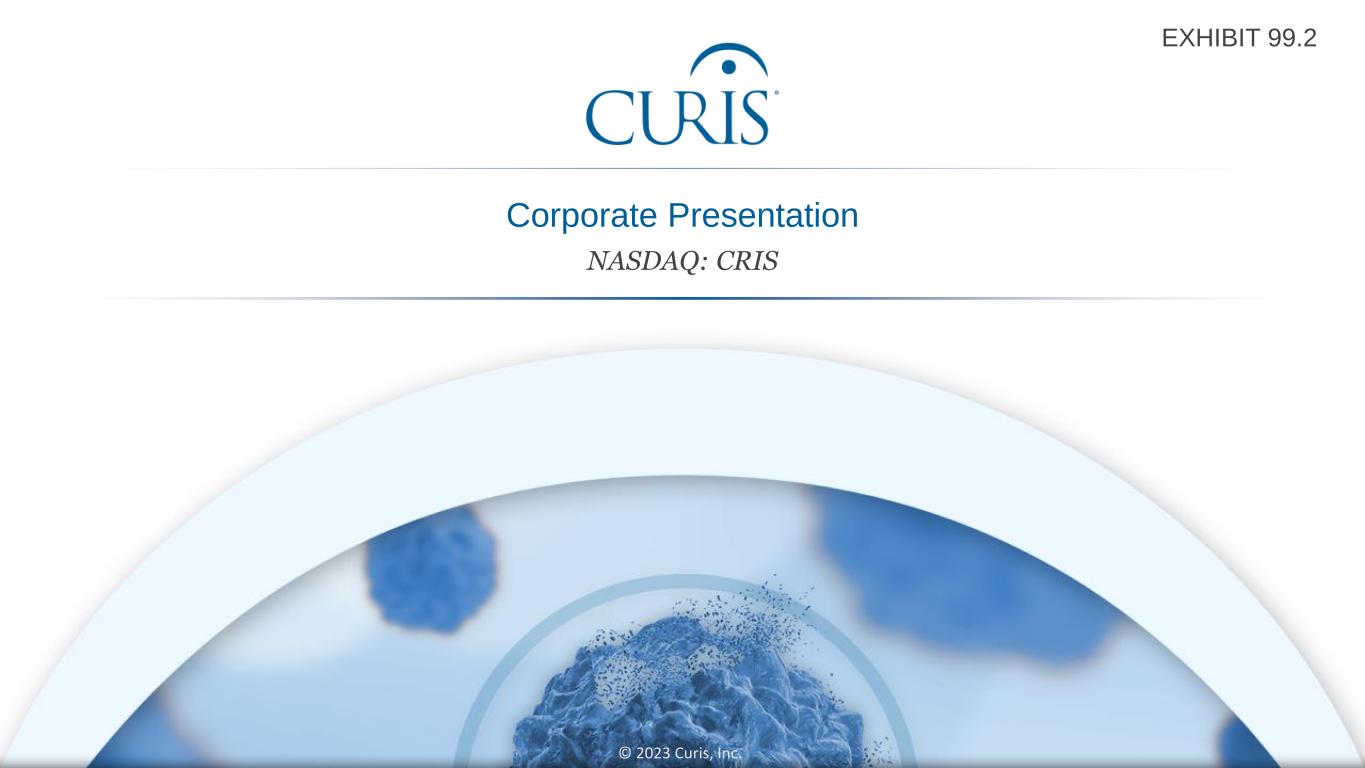
Corporate Presentation NASDAQ: CRIS © 2023 Curis, Inc. EXHIBIT 99.2
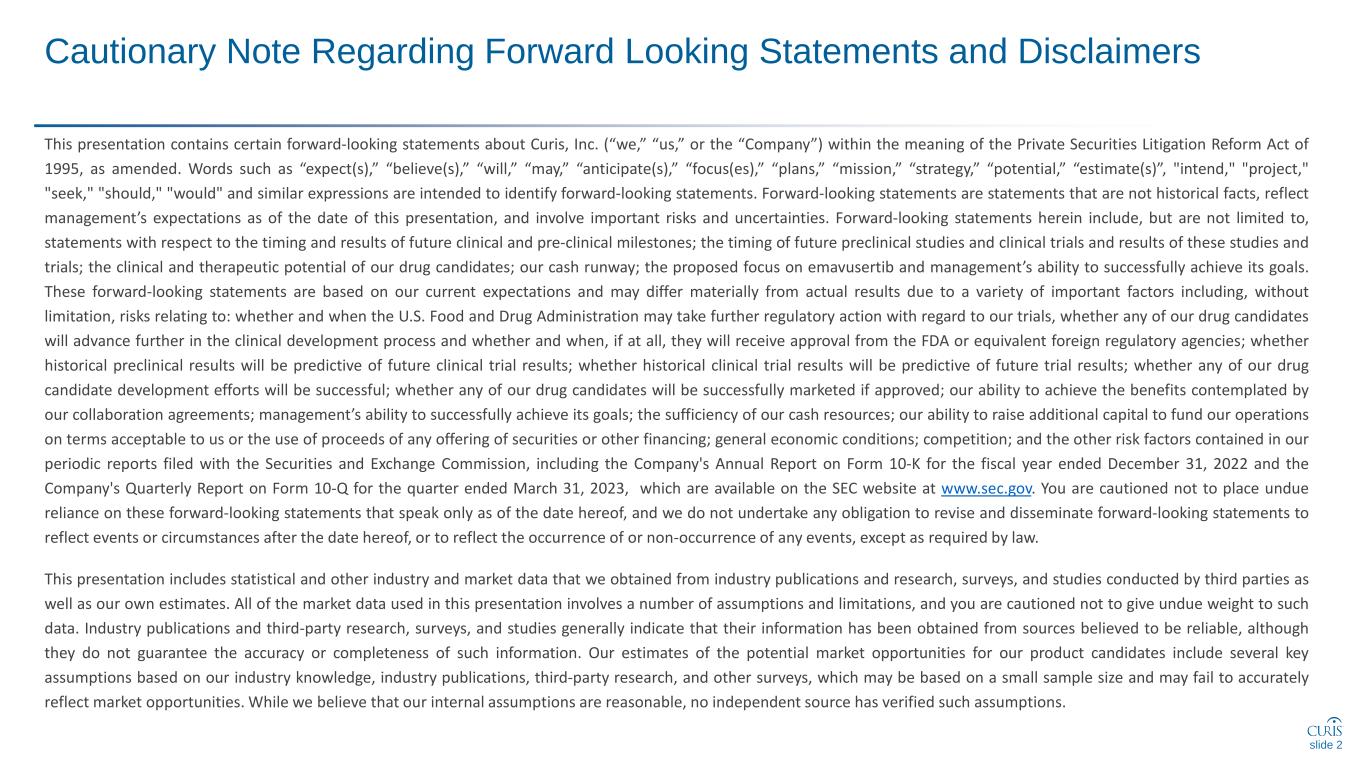
Cautionary Note Regarding Forward Looking Statements and Disclaimers This presentation contains certain forward-looking statements about Curis, Inc. (“we,” “us,” or the “Company”) within the meaning of the Private Securities Litigation Reform Act of 1995, as amended. Words such as “expect(s),” “believe(s),” “will,” “may,” “anticipate(s),” “focus(es),” “plans,” “mission,” “strategy,” “potential,” “estimate(s)”, "intend," "project," "seek," "should," "would" and similar expressions are intended to identify forward-looking statements. Forward-looking statements are statements that are not historical facts, reflect management’s expectations as of the date of this presentation, and involve important risks and uncertainties. Forward-looking statements herein include, but are not limited to, statements with respect to the timing and results of future clinical and pre-clinical milestones; the timing of future preclinical studies and clinical trials and results of these studies and trials; the clinical and therapeutic potential of our drug candidates; our cash runway; the proposed focus on emavusertib and management’s ability to successfully achieve its goals. These forward-looking statements are based on our current expectations and may differ materially from actual results due to a variety of important factors including, without limitation, risks relating to: whether and when the U.S. Food and Drug Administration may take further regulatory action with regard to our trials, whether any of our drug candidates will advance further in the clinical development process and whether and when, if at all, they will receive approval from the FDA or equivalent foreign regulatory agencies; whether historical preclinical results will be predictive of future clinical trial results; whether historical clinical trial results will be predictive of future trial results; whether any of our drug candidate development efforts will be successful; whether any of our drug candidates will be successfully marketed if approved; our ability to achieve the benefits contemplated by our collaboration agreements; management’s ability to successfully achieve its goals; the sufficiency of our cash resources; our ability to raise additional capital to fund our operations on terms acceptable to us or the use of proceeds of any offering of securities or other financing; general economic conditions; competition; and the other risk factors contained in our periodic reports filed with the Securities and Exchange Commission, including the Company's Annual Report on Form 10-K for the fiscal year ended December 31, 2022 and the Company's Quarterly Report on Form 10-Q for the quarter ended March 31, 2023, which are available on the SEC website at www.sec.gov. You are cautioned not to place undue reliance on these forward-looking statements that speak only as of the date hereof, and we do not undertake any obligation to revise and disseminate forward-looking statements to reflect events or circumstances after the date hereof, or to reflect the occurrence of or non-occurrence of any events, except as required by law. This presentation includes statistical and other industry and market data that we obtained from industry publications and research, surveys, and studies conducted by third parties as well as our own estimates. All of the market data used in this presentation involves a number of assumptions and limitations, and you are cautioned not to give undue weight to such data. Industry publications and third-party research, surveys, and studies generally indicate that their information has been obtained from sources believed to be reliable, although they do not guarantee the accuracy or completeness of such information. Our estimates of the potential market opportunities for our product candidates include several key assumptions based on our industry knowledge, industry publications, third-party research, and other surveys, which may be based on a small sample size and may fail to accurately reflect market opportunities. While we believe that our internal assumptions are reasonable, no independent source has verified such assumptions. slide 2
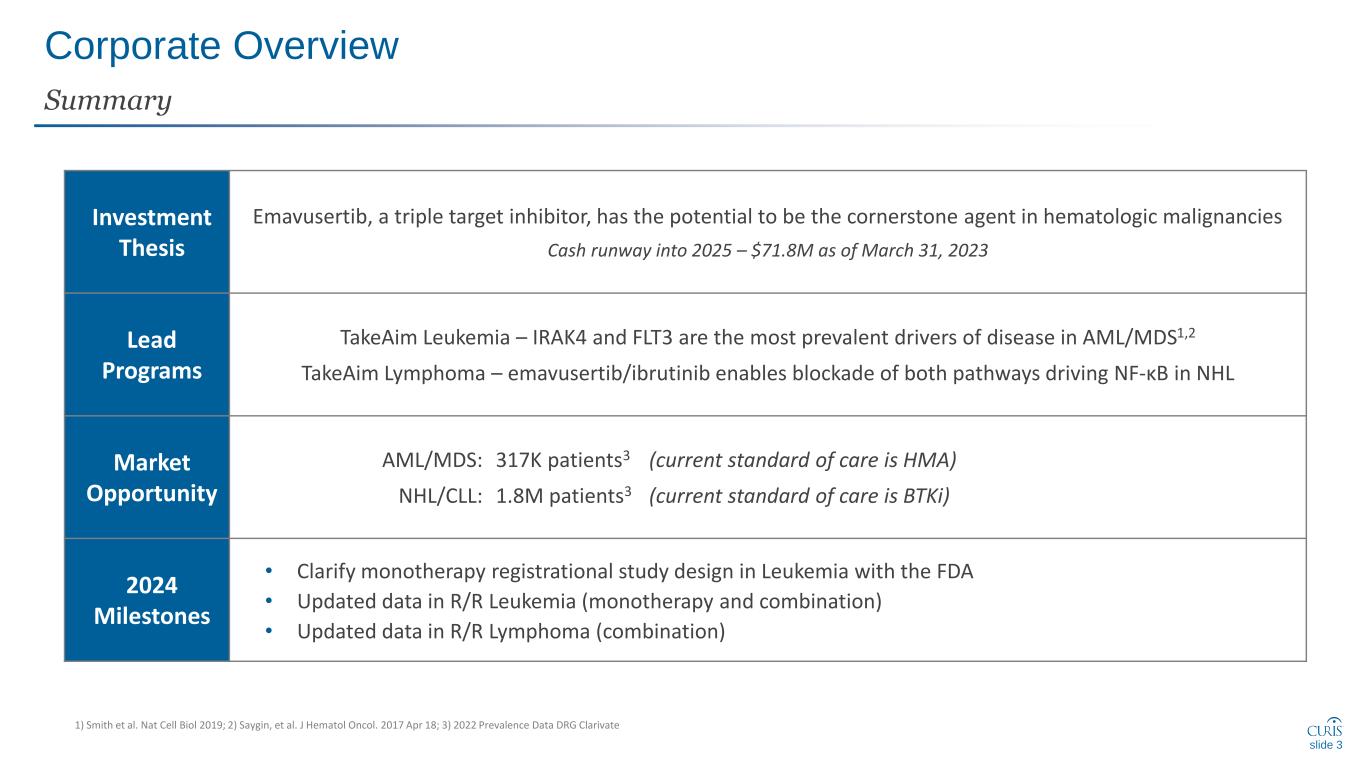
Investment Thesis Emavusertib, a triple target inhibitor, has the potential to be the cornerstone agent in hematologic malignancies Cash runway into 2025 – $71.8M as of March 31, 2023 Lead Programs TakeAim Leukemia – IRAK4 and FLT3 are the most prevalent drivers of disease in AML/MDS1,2 TakeAim Lymphoma – emavusertib/ibrutinib enables blockade of both pathways driving NF-ĸB in NHL Market Opportunity AML/MDS: 317K patients3 (current standard of care is HMA) NHL/CLL: 1.8M patients3 (current standard of care is BTKi) 2024 Milestones • Clarify monotherapy registrational study design in Leukemia with the FDA • Updated data in R/R Leukemia (monotherapy and combination) • Updated data in R/R Lymphoma (combination) slide 3 Corporate Overview Summary 1) Smith et al. Nat Cell Biol 2019; 2) Saygin, et al. J Hematol Oncol. 2017 Apr 18; 3) 2022 Prevalence Data DRG Clarivate
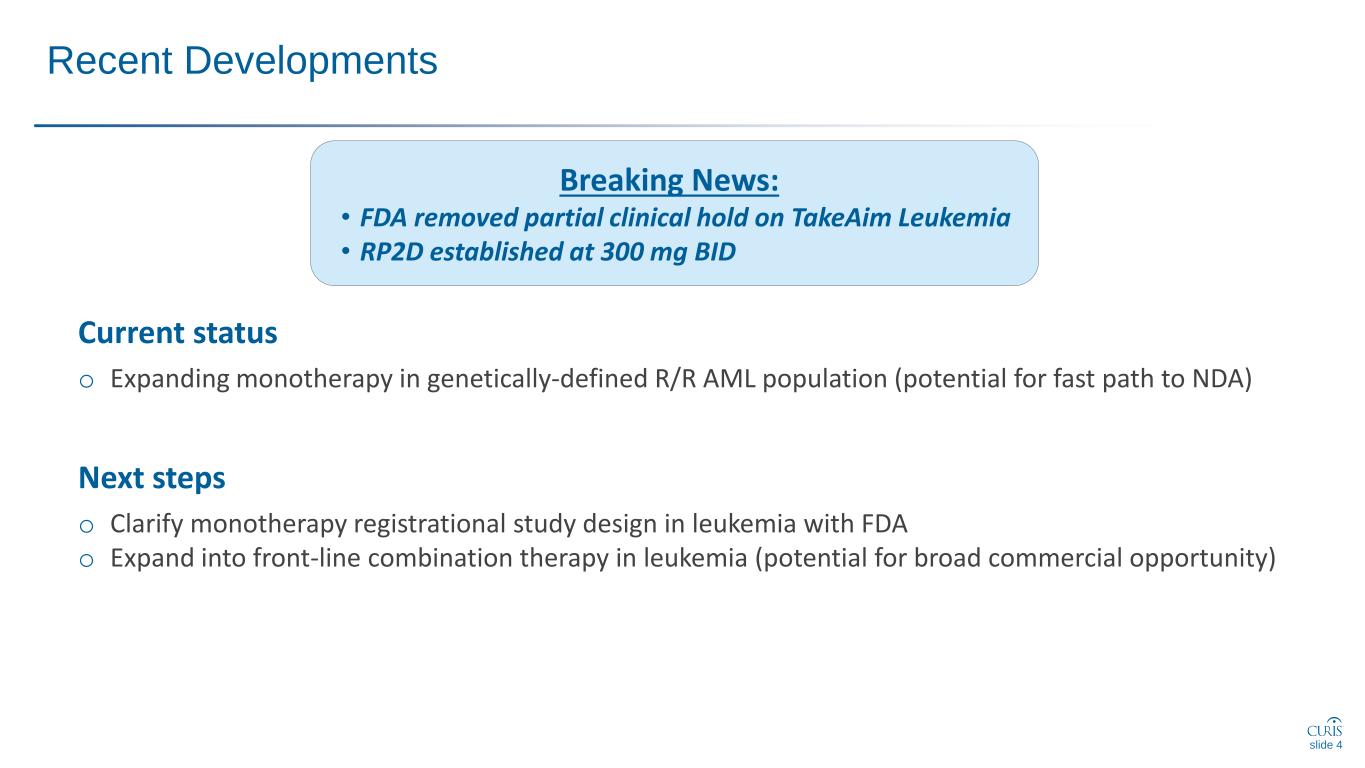
Recent Developments Current status o Expanding monotherapy in genetically-defined R/R AML population (potential for fast path to NDA) Next steps o Clarify monotherapy registrational study design in leukemia with FDA o Expand into front-line combination therapy in leukemia (potential for broad commercial opportunity) slide 4 Breaking News: • FDA removed partial clinical hold on TakeAim Leukemia • RP2D established at 300 mg BID
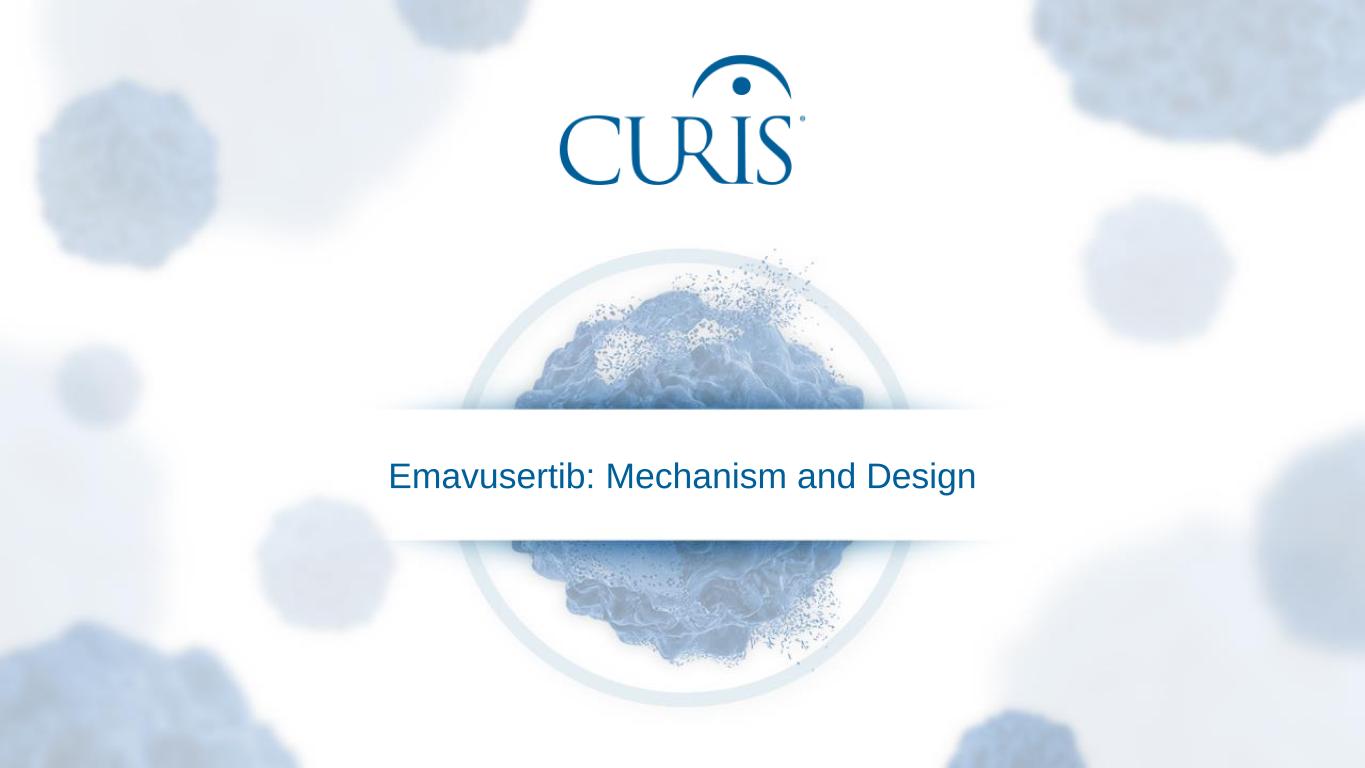
Emavusertib: Mechanism and Design
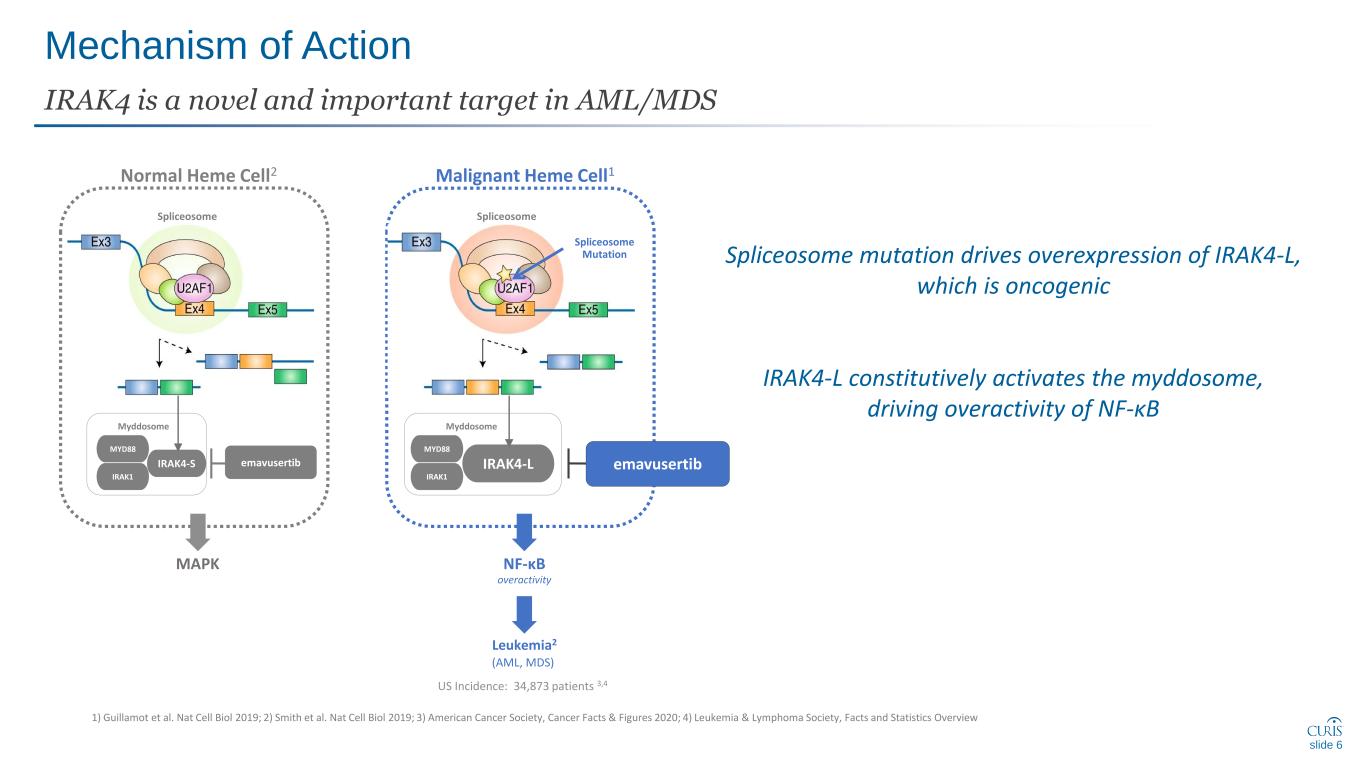
Mechanism of Action IRAK4 is a novel and important target in AML/MDS 1) Guillamot et al. Nat Cell Biol 2019; 2) Smith et al. Nat Cell Biol 2019; 3) American Cancer Society, Cancer Facts & Figures 2020; 4) Leukemia & Lymphoma Society, Facts and Statistics Overview Myddosome IRAK1 IRAK4-S MYD88 Myddosome IRAK1 IRAK4-L MYD88 Malignant Heme Cell1 Spliceosome Spliceosome Normal Heme Cell2 Spliceosome Mutation US Incidence: 34,873 patients 3,4 emavusertib Leukemia2 (AML, MDS) NF-κB emavusertib overactivity MAPK slide 6 Spliceosome mutation drives overexpression of IRAK4-L, which is oncogenic IRAK4-L constitutively activates the myddosome, driving overactivity of NF-ĸB
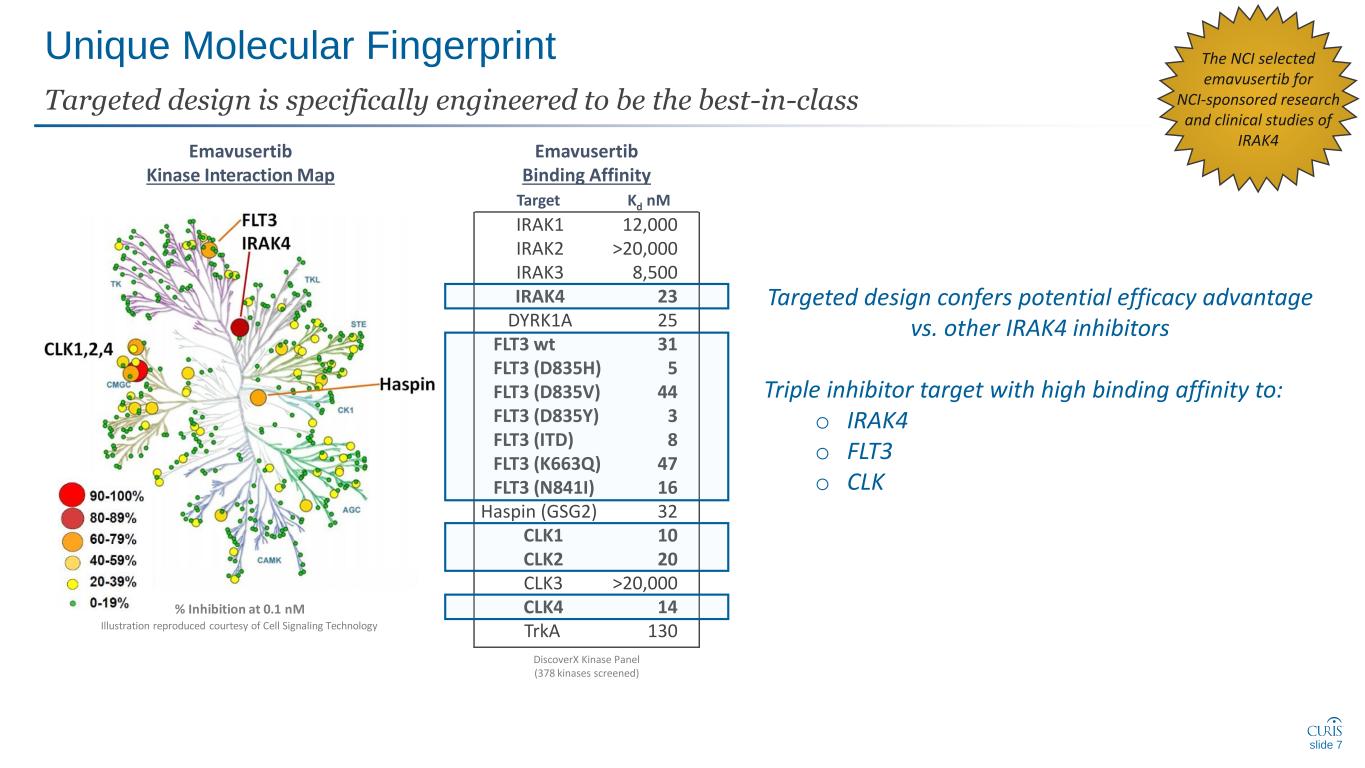
Unique Molecular Fingerprint Targeted design is specifically engineered to be the best-in-class Emavusertib Kinase Interaction Map % Inhibition at 0.1 nM Illustration reproduced courtesy of Cell Signaling Technology Target Kd nM IRAK1 12,000 IRAK2 >20,000 IRAK3 8,500 IRAK4 23 DYRK1A 25 FLT3 wt FLT3 (D835H) 31 5 FLT3 (D835V) 44 FLT3 (D835Y) 3 FLT3 (ITD) 8 FLT3 (K663Q) 47 FLT3 (N841I) 16 Haspin (GSG2) 32 CLK1 10 CLK2 20 CLK3 >20,000 CLK4 14 TrkA 130 Emavusertib Binding Affinity DiscoverX Kinase Panel (378 kinases screened) The NCI selected emavusertib for NCI-sponsored research and clinical studies of IRAK4 slide 7 Triple inhibitor target with high binding affinity to: o IRAK4 o FLT3 o CLK Targeted design confers potential efficacy advantage vs. other IRAK4 inhibitors
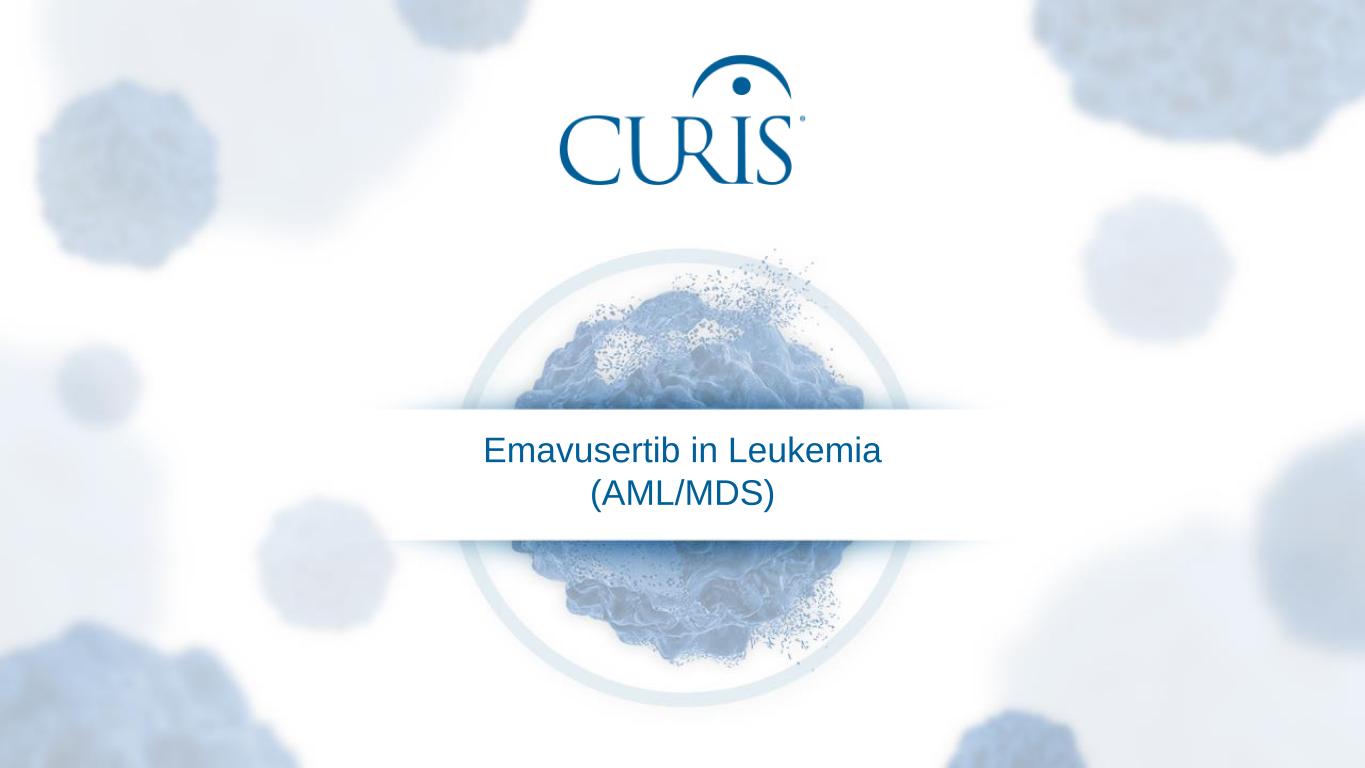
Emavusertib in Leukemia (AML/MDS)
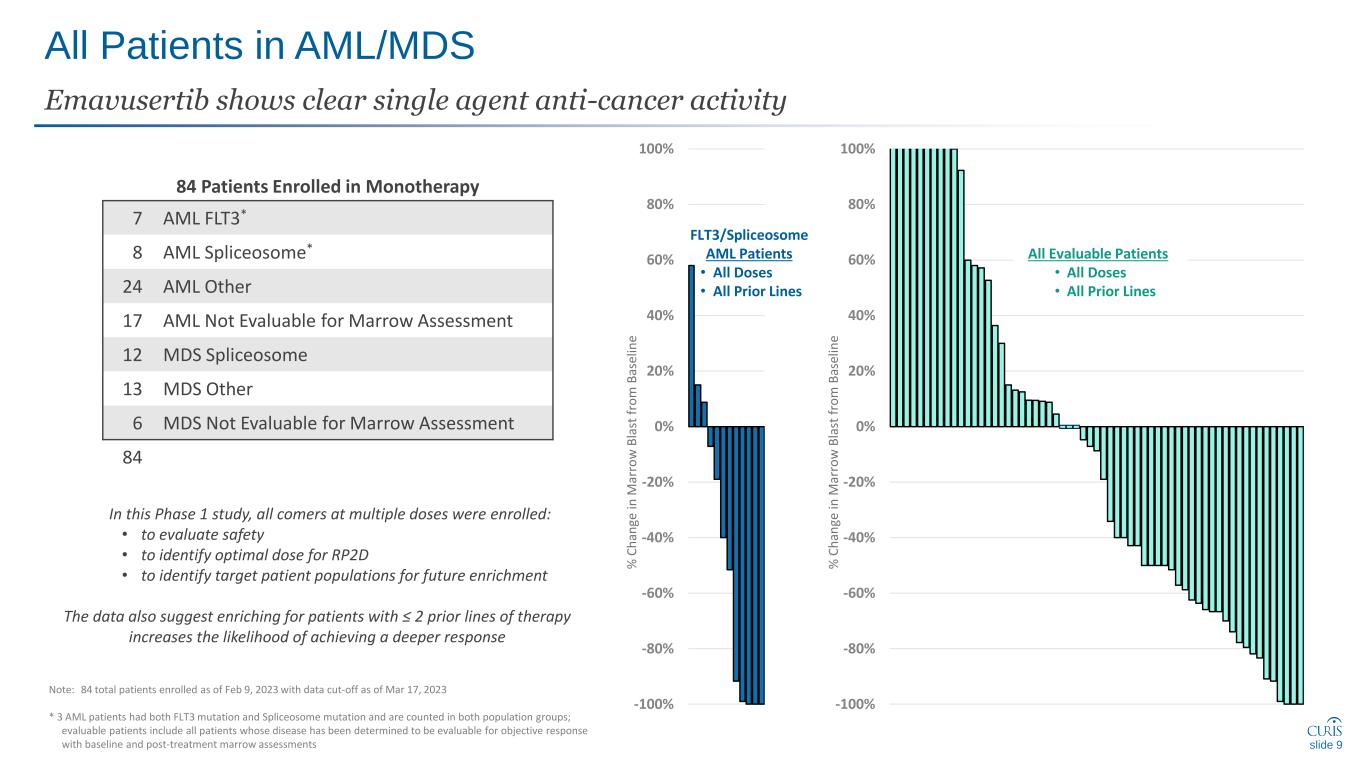
-100% -80% -60% -40% -20% 0% 20% 40% 60% 80% 100% -100% -80% -60% -40% -20% 0% 20% 40% 60% 80% 100% All Patients in AML/MDS Emavusertib shows clear single agent anti-cancer activity slide 9 Note: 84 total patients enrolled as of Feb 9, 2023 with data cut-off as of Mar 17, 2023 * 3 AML patients had both FLT3 mutation and Spliceosome mutation and are counted in both population groups; evaluable patients include all patients whose disease has been determined to be evaluable for objective response with baseline and post-treatment marrow assessments 84 Patients Enrolled in Monotherapy 7 AML FLT3* 8 AML Spliceosome* 24 AML Other 17 AML Not Evaluable for Marrow Assessment 12 MDS Spliceosome 13 MDS Other 6 MDS Not Evaluable for Marrow Assessment 84 In this Phase 1 study, all comers at multiple doses were enrolled: • to evaluate safety • to identify optimal dose for RP2D • to identify target patient populations for future enrichment The data also suggest enriching for patients with ≤ 2 prior lines of therapy increases the likelihood of achieving a deeper response FLT3/Spliceosome AML Patients • All Doses • All Prior Lines All Evaluable Patients • All Doses • All Prior Lines % C h an ge in M ar ro w B la st f ro m B as el in e % C h an ge in M ar ro w B la st f ro m B as el in e
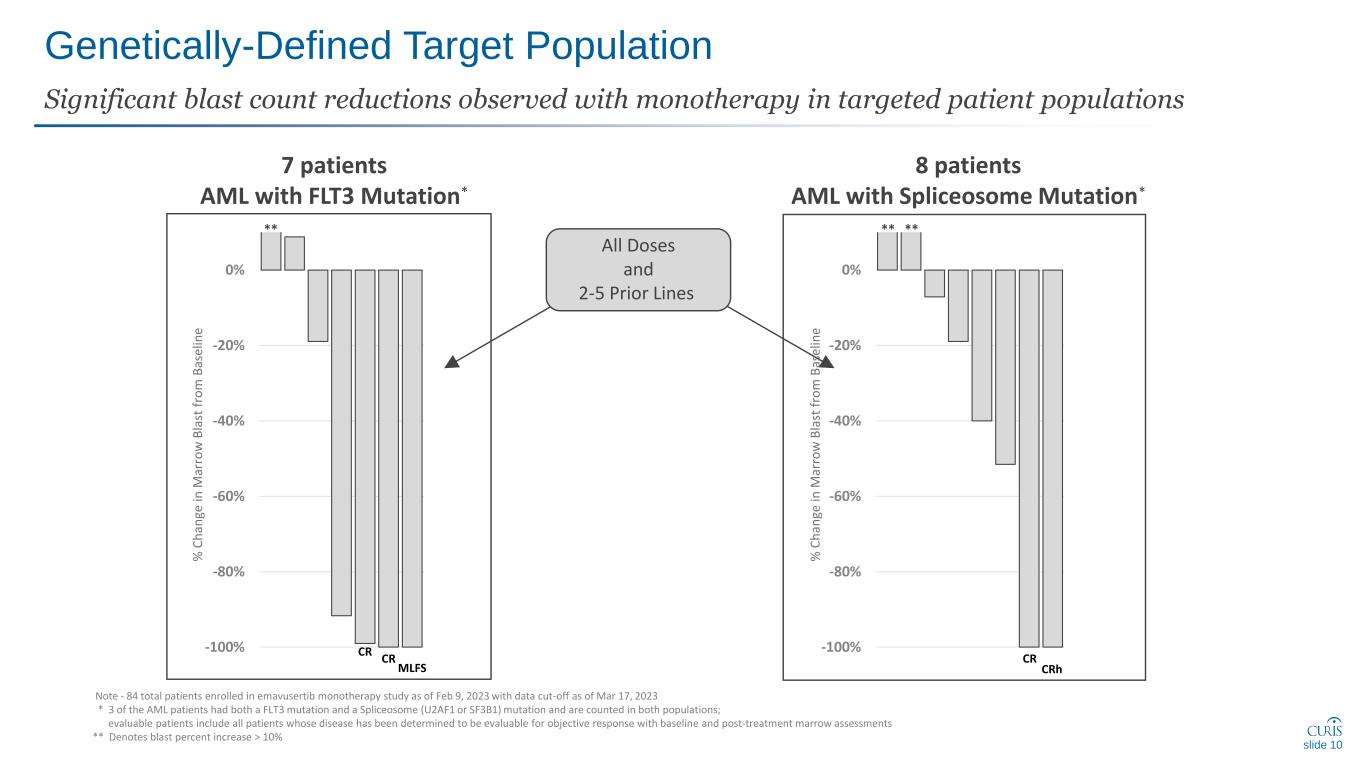
Genetically-Defined Target Population Significant blast count reductions observed with monotherapy in targeted patient populations slide 10 CR CR MLFS -100% -80% -60% -40% -20% 0% CR CRh -100% -80% -60% -40% -20% 0% ** 7 patients AML with FLT3 Mutation* 8 patients AML with Spliceosome Mutation* ** ** All Doses and 2-5 Prior Lines Note - 84 total patients enrolled in emavusertib monotherapy study as of Feb 9, 2023 with data cut-off as of Mar 17, 2023 * 3 of the AML patients had both a FLT3 mutation and a Spliceosome (U2AF1 or SF3B1) mutation and are counted in both populations; evaluable patients include all patients whose disease has been determined to be evaluable for objective response with baseline and post-treatment marrow assessments ** Denotes blast percent increase > 10% % C h an ge in M ar ro w B la st f ro m B as el in e % C h an ge in M ar ro w B la st f ro m B as el in e
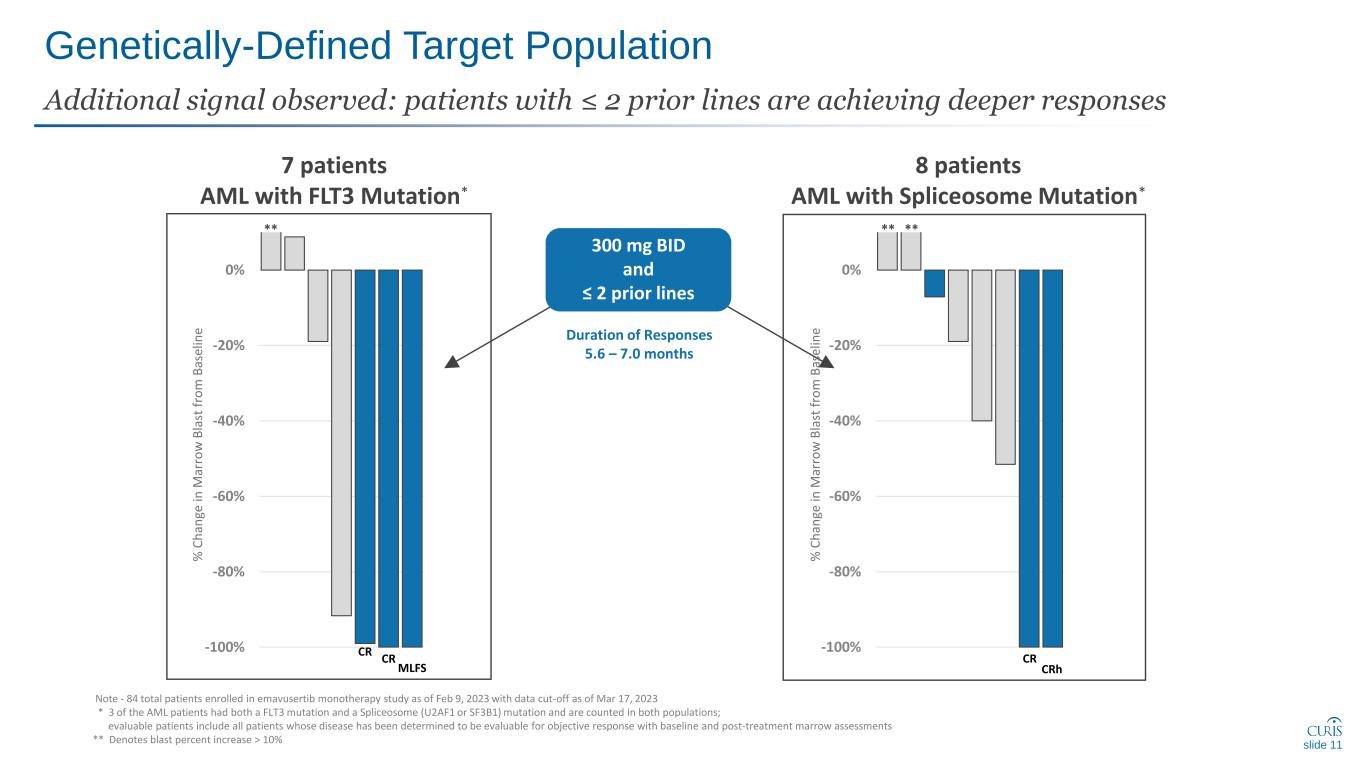
CR CR MLFS -100% -80% -60% -40% -20% 0% CR CRh -100% -80% -60% -40% -20% 0% Genetically-Defined Target Population Additional signal observed: patients with ≤ 2 prior lines are achieving deeper responses slide 11 ** 7 patients AML with FLT3 Mutation* 8 patients AML with Spliceosome Mutation* ** ** 300 mg BID and ≤ 2 prior lines Duration of Responses 5.6 – 7.0 months % C h an ge in M ar ro w B la st f ro m B as el in e % C h an ge in M ar ro w B la st f ro m B as el in e Note - 84 total patients enrolled in emavusertib monotherapy study as of Feb 9, 2023 with data cut-off as of Mar 17, 2023 * 3 of the AML patients had both a FLT3 mutation and a Spliceosome (U2AF1 or SF3B1) mutation and are counted in both populations; evaluable patients include all patients whose disease has been determined to be evaluable for objective response with baseline and post-treatment marrow assessments ** Denotes blast percent increase > 10%
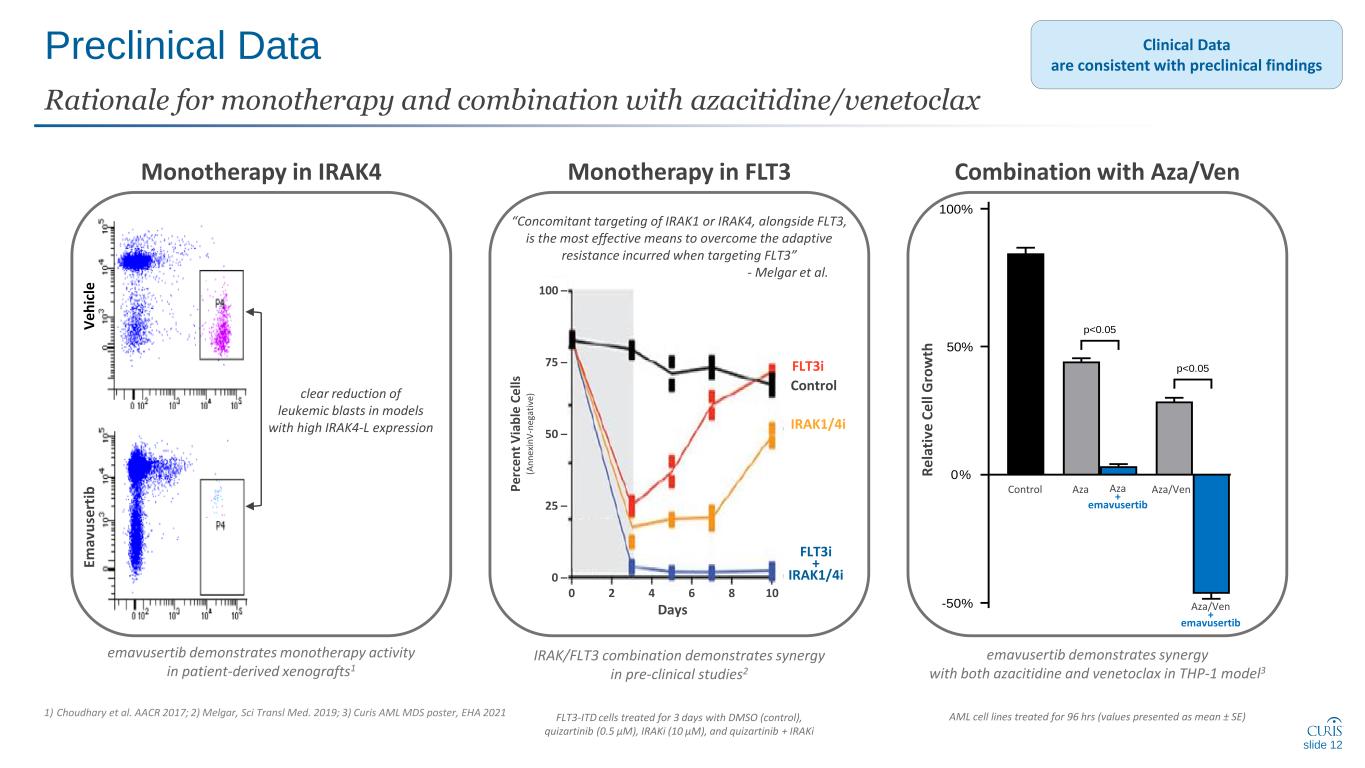
0% p<0.05 p<0.05 50% 100% -50% Preclinical Data Rationale for monotherapy and combination with azacitidine/venetoclax 1) Choudhary et al. AACR 2017; 2) Melgar, Sci Transl Med. 2019; 3) Curis AML MDS poster, EHA 2021 Control R e la ti ve C el l G ro w th Aza Aza + emavusertib Aza/Ven slide 12 Clinical Data are consistent with preclinical findings emavusertib demonstrates synergy with both azacitidine and venetoclax in THP-1 model3 AML cell lines treated for 96 hrs (values presented as mean ± SE) Aza/Ven + emavusertib V e h ic le Em av u se rt ib emavusertib demonstrates monotherapy activity in patient-derived xenografts1 clear reduction of leukemic blasts in models with high IRAK4-L expression IRAK/FLT3 combination demonstrates synergy in pre-clinical studies2 FLT3-ITD cells treated for 3 days with DMSO (control), quizartinib (0.5 μM), IRAKi (10 μM), and quizartinib + IRAKi Combination with Aza/VenMonotherapy in IRAK4 Monotherapy in FLT3 0 2 4 6 8 10 FLT3i + IRAK1/4i FLT3i Control IRAK1/4i 100 – 75 – 50 – 25 – 0 – P e rc e n t V ia b le C e lls (A n n ex in V -n eg at iv e) “Concomitant targeting of IRAK1 or IRAK4, alongside FLT3, is the most effective means to overcome the adaptive resistance incurred when targeting FLT3” - Melgar et al. Days
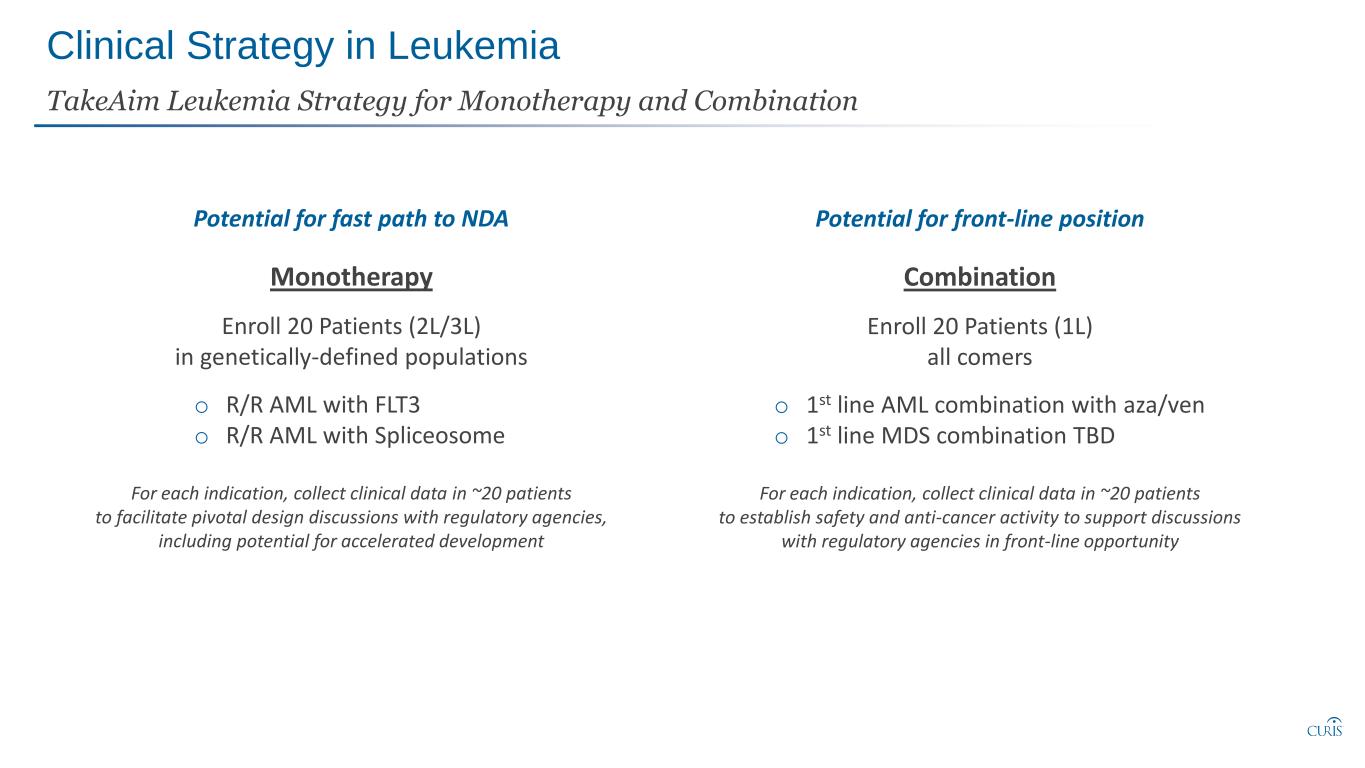
Clinical Strategy in Leukemia TakeAim Leukemia Strategy for Monotherapy and Combination Potential for front-line position Combination Enroll 20 Patients (1L) all comers o 1st line AML combination with aza/ven o 1st line MDS combination TBD For each indication, collect clinical data in ~20 patients to establish safety and anti-cancer activity to support discussions with regulatory agencies in front-line opportunity Potential for fast path to NDA Monotherapy Enroll 20 Patients (2L/3L) in genetically-defined populations o R/R AML with FLT3 o R/R AML with Spliceosome For each indication, collect clinical data in ~20 patients to facilitate pivotal design discussions with regulatory agencies, including potential for accelerated development
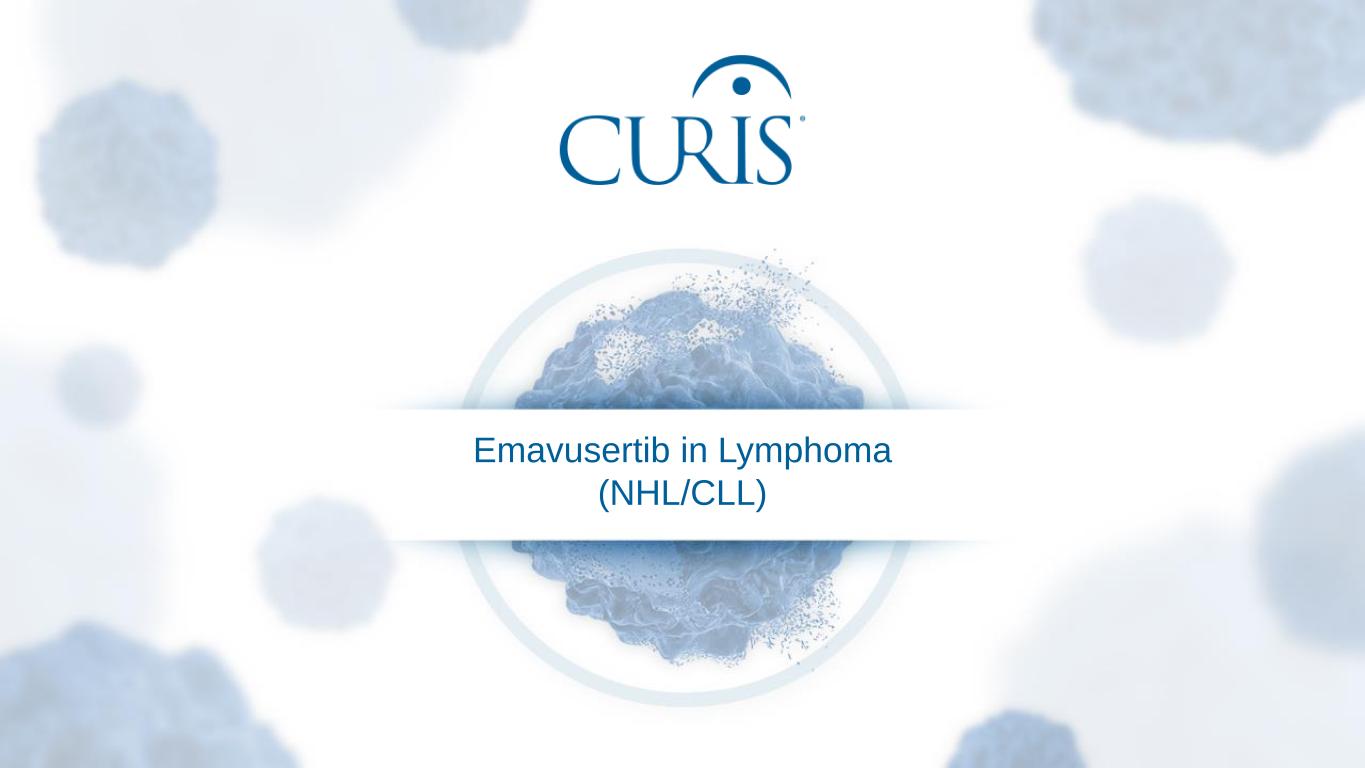
Emavusertib in Lymphoma (NHL/CLL)
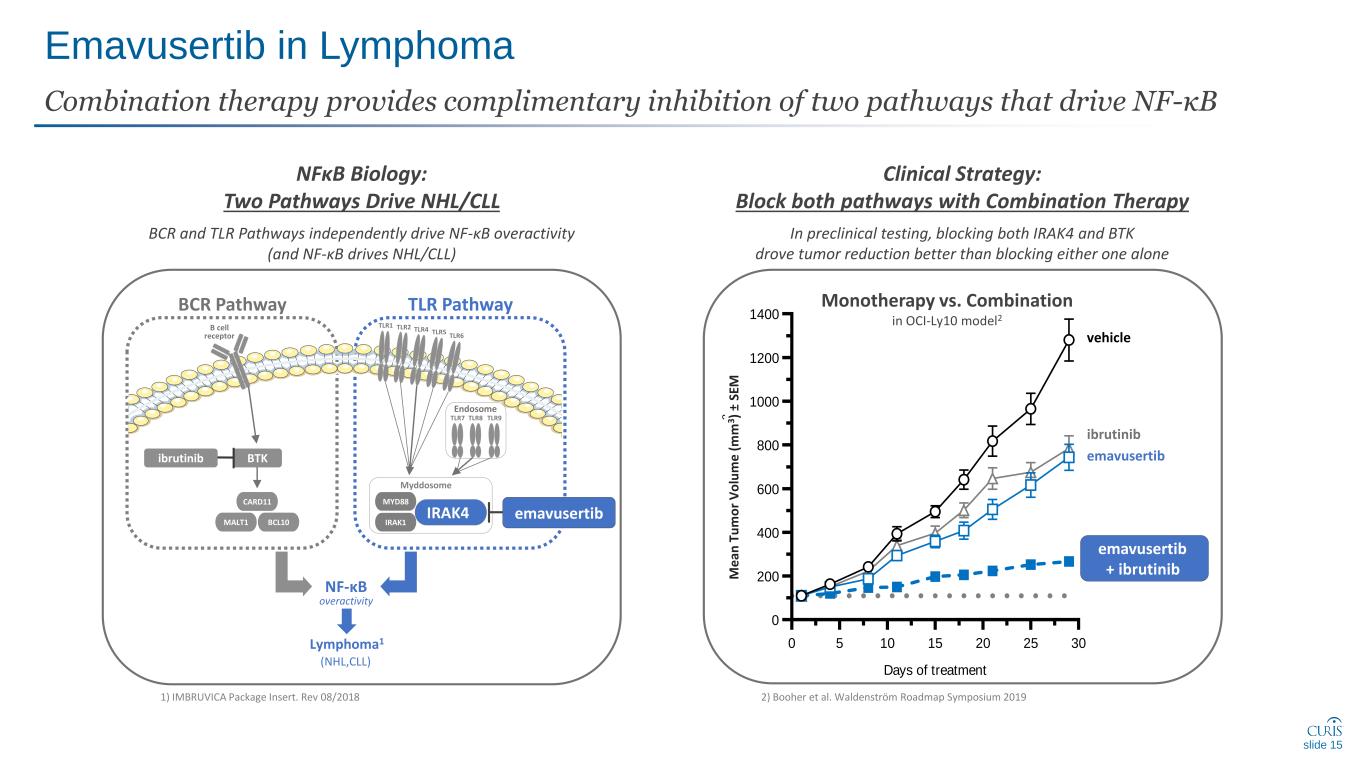
Emavusertib in Lymphoma Combination therapy provides complimentary inhibition of two pathways that drive NF-κB NFκB Biology: Two Pathways Drive NHL/CLL BCR and TLR Pathways independently drive NF-κB overactivity (and NF-κB drives NHL/CLL) Clinical Strategy: Block both pathways with Combination Therapy In preclinical testing, blocking both IRAK4 and BTK drove tumor reduction better than blocking either one alone 2) Booher et al. Waldenström Roadmap Symposium 20191) IMBRUVICA Package Insert. Rev 08/2018 TLR1B cell receptor BTK CARD11 MALT1 BCL10 ibrutinib TLR2 TLR4 TLR5 TLR6 TLR7 TLR8 TLR9 BCR Pathway TLR Pathway Endosome Lymphoma1 (NHL,CLL) NF-κB Myddosome IRAK1 IRAK4 MYD88 emavusertib overactivity slide 15 vehicle ibrutinib emavusertib CA-4948 + Ibrutinib Tumor Growth in OCI-Ly10 Model 0 5 10 15 20 25 30 0 200 400 600 800 1000 1200 1400 Days of treatment M e a n T u m o r V o lu m e ( m m 3 ) + S E M Dosing: QDx28, PO Vehicle Ibrutinib, 12.5 mg/kg CA-4948, 100 mg/kg + Ibrutinib, 12.5 mg/kg CA-4948, 100 mg/kg 87% TGI M e an T u m o r V o lu m e ( m m 3 ) ± SE M Monotherapy vs. Combination in OCI-Ly10 model2 emavusertib + ibrutinib
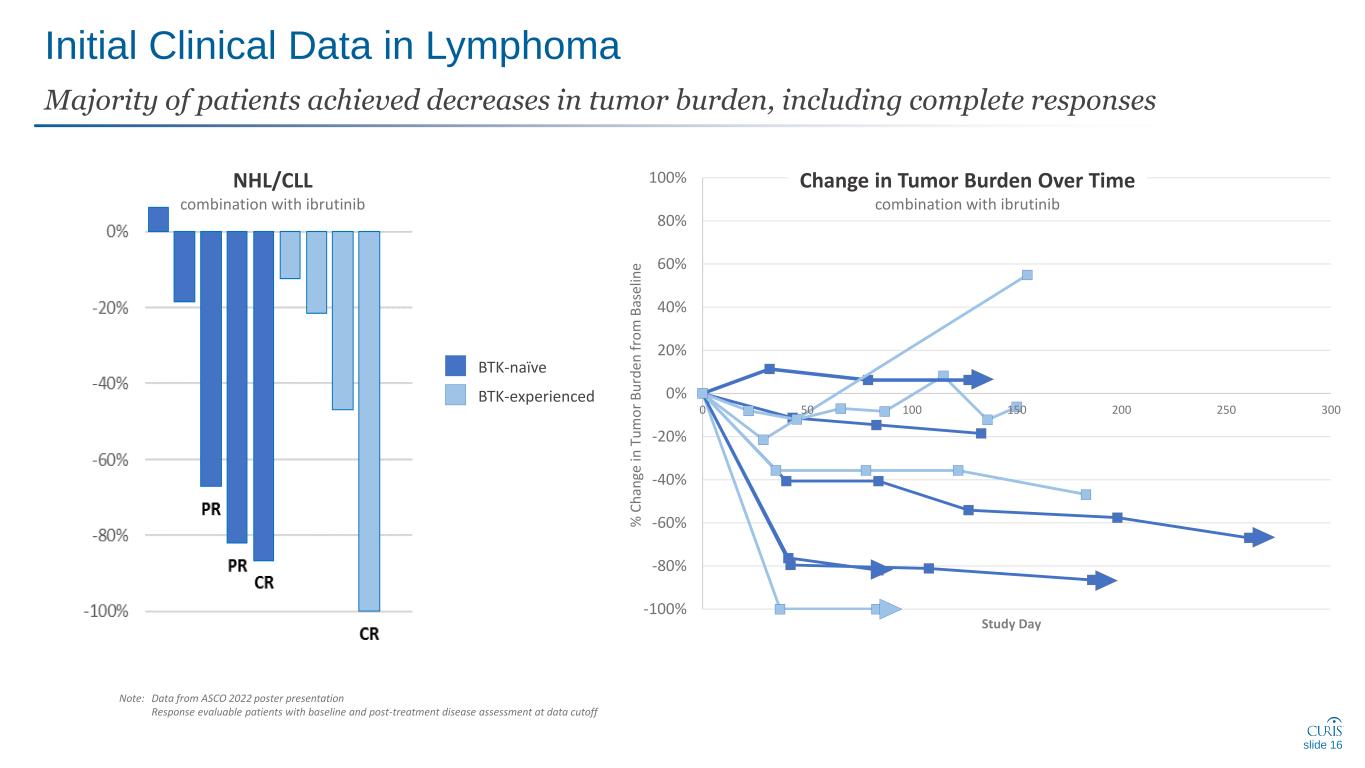
Initial Clinical Data in Lymphoma Majority of patients achieved decreases in tumor burden, including complete responses -100% -80% -60% -40% -20% 0% 20% 40% 60% 80% 100% 0 50 100 150 200 250 300 % C h an ge in T u m o r B u rd en f ro m B as el in e Study Day slide 16 BTK-naïve BTK-experienced NHL/CLL combination with ibrutinib Note: Data from ASCO 2022 poster presentation Response evaluable patients with baseline and post-treatment disease assessment at data cutoff Change in Tumor Burden Over Time combination with ibrutinib
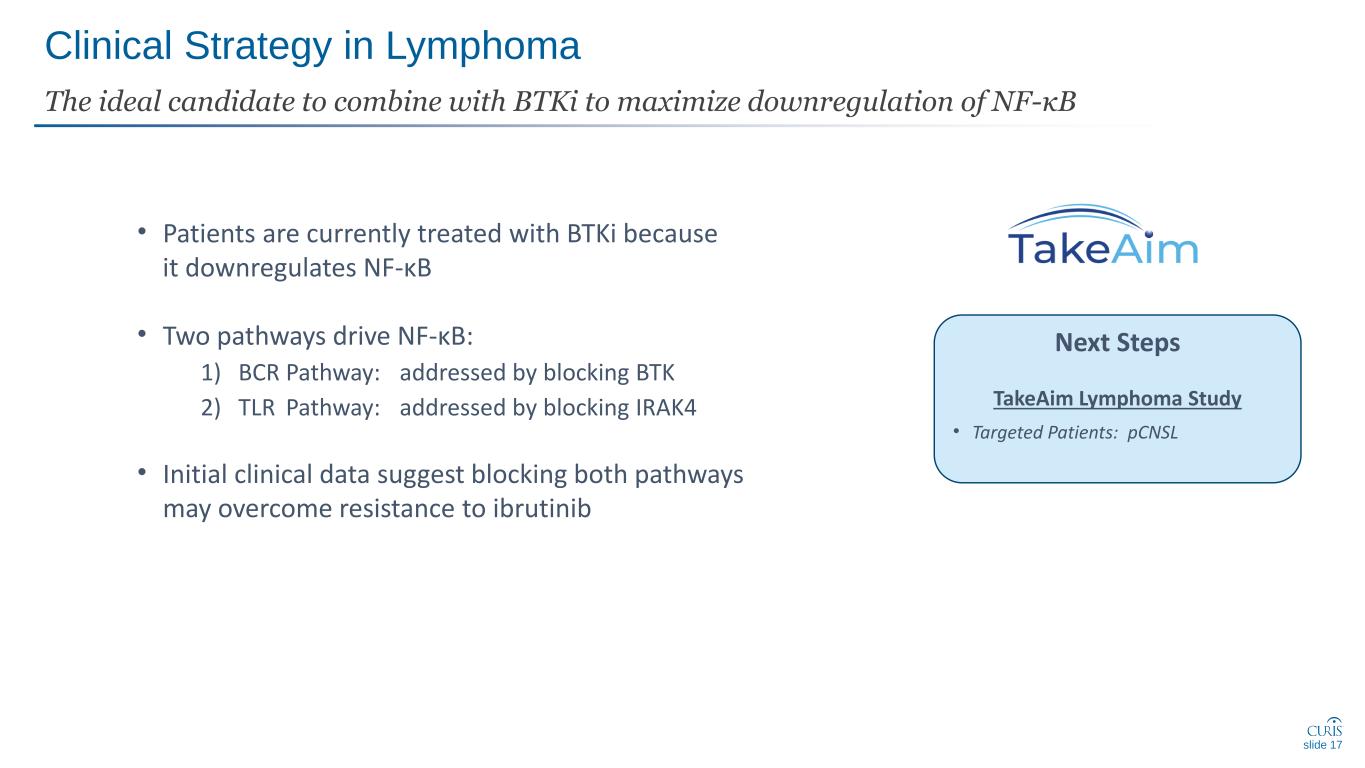
Clinical Strategy in Lymphoma The ideal candidate to combine with BTKi to maximize downregulation of NF-κB • Patients are currently treated with BTKi because it downregulates NF-κB • Two pathways drive NF-κB: 1) BCR Pathway: addressed by blocking BTK 2) TLR Pathway: addressed by blocking IRAK4 • Initial clinical data suggest blocking both pathways may overcome resistance to ibrutinib Next Steps TakeAim Lymphoma Study • Targeted Patients: pCNSL slide 17
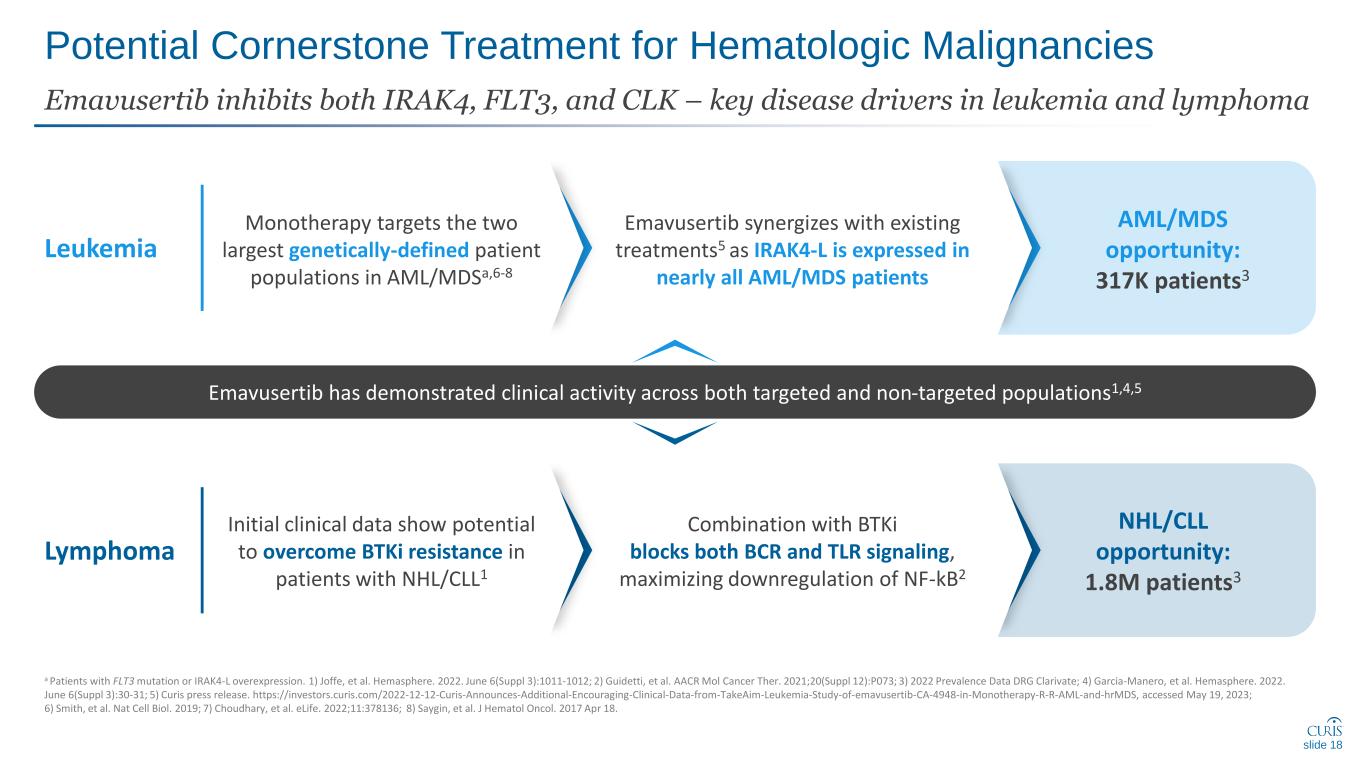
Leukemia Emavusertib synergizes with existing treatments5 as IRAK4-L is expressed in nearly all AML/MDS patients Monotherapy targets the two largest genetically-defined patient populations in AML/MDSa,6-8 Lymphoma Potential Cornerstone Treatment for Hematologic Malignancies Emavusertib inhibits both IRAK4, FLT3, and CLK – key disease drivers in leukemia and lymphoma Emavusertib has demonstrated clinical activity across both targeted and non-targeted populations1,4,5 a Patients with FLT3 mutation or IRAK4-L overexpression. 1) Joffe, et al. Hemasphere. 2022. June 6(Suppl 3):1011-1012; 2) Guidetti, et al. AACR Mol Cancer Ther. 2021;20(Suppl 12):P073; 3) 2022 Prevalence Data DRG Clarivate; 4) Garcia-Manero, et al. Hemasphere. 2022. June 6(Suppl 3):30-31; 5) Curis press release. https://investors.curis.com/2022-12-12-Curis-Announces-Additional-Encouraging-Clinical-Data-from-TakeAim-Leukemia-Study-of-emavusertib-CA-4948-in-Monotherapy-R-R-AML-and-hrMDS, accessed May 19, 2023; 6) Smith, et al. Nat Cell Biol. 2019; 7) Choudhary, et al. eLife. 2022;11:378136; 8) Saygin, et al. J Hematol Oncol. 2017 Apr 18. Initial clinical data show potential to overcome BTKi resistance in patients with NHL/CLL1 NHL/CLL opportunity: 1.8M patients3 AML/MDS opportunity: 317K patients3 Combination with BTKi blocks both BCR and TLR signaling, maximizing downregulation of NF-kB2 slide 18
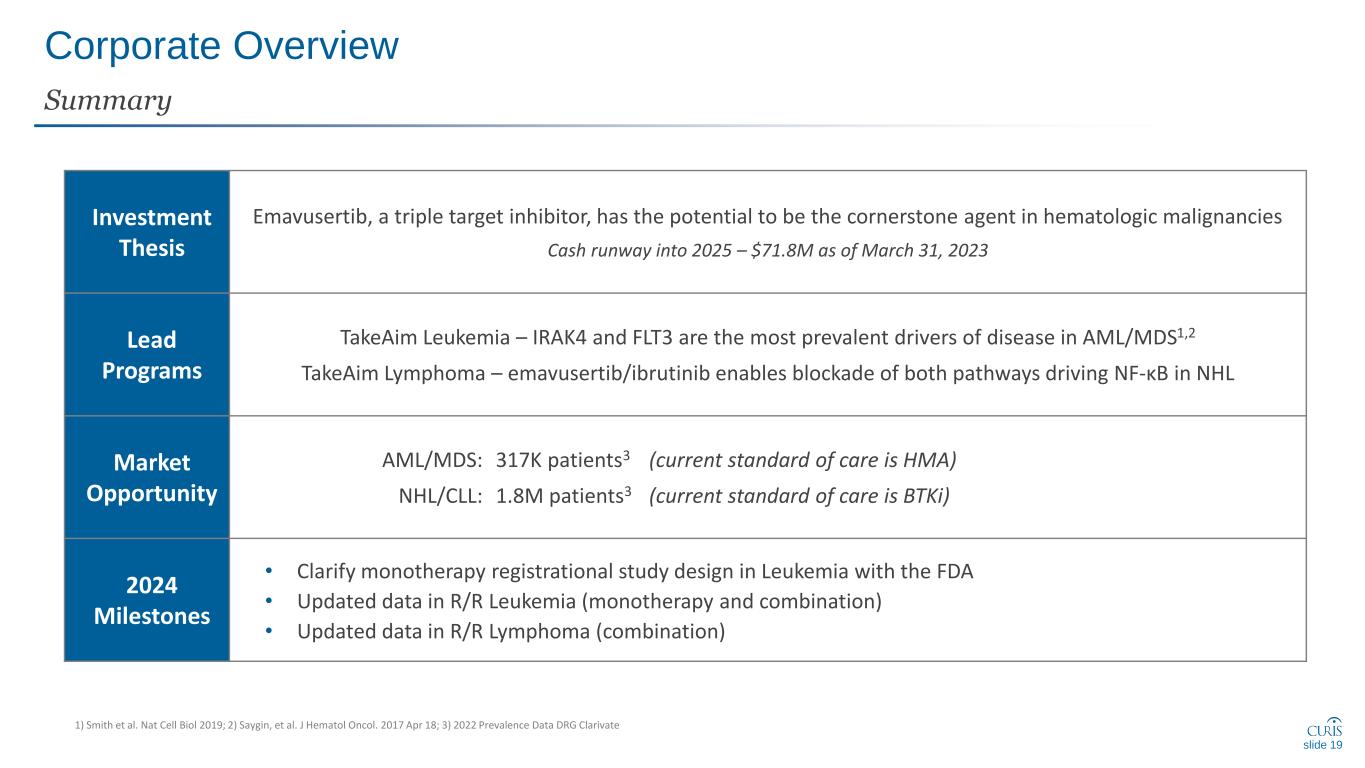
Investment Thesis Emavusertib, a triple target inhibitor, has the potential to be the cornerstone agent in hematologic malignancies Cash runway into 2025 – $71.8M as of March 31, 2023 Lead Programs TakeAim Leukemia – IRAK4 and FLT3 are the most prevalent drivers of disease in AML/MDS1,2 TakeAim Lymphoma – emavusertib/ibrutinib enables blockade of both pathways driving NF-ĸB in NHL Market Opportunity AML/MDS: 317K patients3 (current standard of care is HMA) NHL/CLL: 1.8M patients3 (current standard of care is BTKi) 2024 Milestones • Clarify monotherapy registrational study design in Leukemia with the FDA • Updated data in R/R Leukemia (monotherapy and combination) • Updated data in R/R Lymphoma (combination) slide 19 Corporate Overview Summary 1) Smith et al. Nat Cell Biol 2019; 2) Saygin, et al. J Hematol Oncol. 2017 Apr 18; 3) 2022 Prevalence Data DRG Clarivate
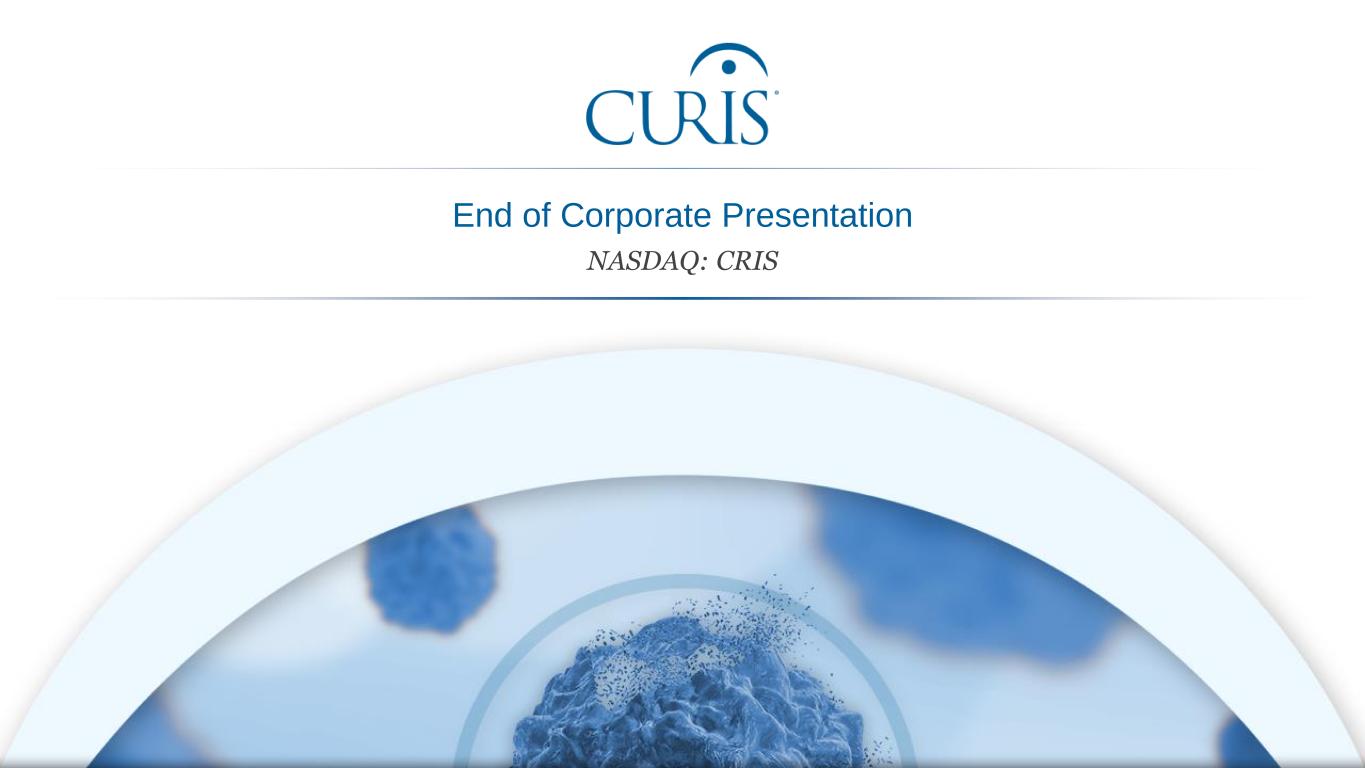
End of Corporate Presentation NASDAQ: CRIS
